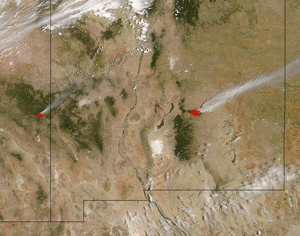According to the National Interagency Fire Center, fire activity across the U.S. has been slightly below average as of the end of May. The fire season typically begins on May 1st and runs through the end of October. However, the pre-season and early-season are often active, as can be seen in the year-to-date statistics in the table below.
In May, several large fires were ignited by lightning in the Southwest, with the largest of these being the KP fire in Arizona and the Peppin fire in New Mexico. MODIS imagery to the left shows these two large fires on May 24th. NOAA's AVHRR satellite imagery also shows the actively burning areas and smoke plumes from these two fires, which continued to burn into the first part of June. Large fire activity in May also occurred in Southern California, Nevada and parts of Florida.
Ongoing, long-term drought conditions across a large portion of the western U.S. have increased the potential for large fires again this year. Current soil and fuel conditions have been worsened by short-term moisture deficits as well, with many areas having the potential for extreme fire behavior. Parts of the intermountain West have experienced four to five years of drought, with severe to extreme drought conditions present over the majority of this region.
| As of May 31, 2004 | Nationwide Number of Fires | Nationwide Number of Acres Burned |
|---|---|---|
| 2004 | 32,068 | 531,270 |
| 2003 | 21,452 | 405,937 |
| 2002 | 30,817 | 1,115,133 |
| 10-year Average | 34,940 | 777,356 |
The dry conditions in the Southwest U.S. have contributed to extremely low Dead Fuel Moisture levels. Fine fuels remained extremely dry across the Southwest and the Four-Corners area, with 10-hr fuel moistures below 5%. Medium to larger fuels (i.e. 100-hr and 1000-hr) also continued to be extremely dry across this area, with 1000-hr fuels below 10% over a broad region of the Southwest. According to the Keetch-Byram Drought Index (KBDI), a widely used index for fire risk, the potential for large fires remained very high across Florida, with areas of the Southwest also showing increasing potential at the end of May.
 NOAA's National Centers for Environmental Information
NOAA's National Centers for Environmental Information
